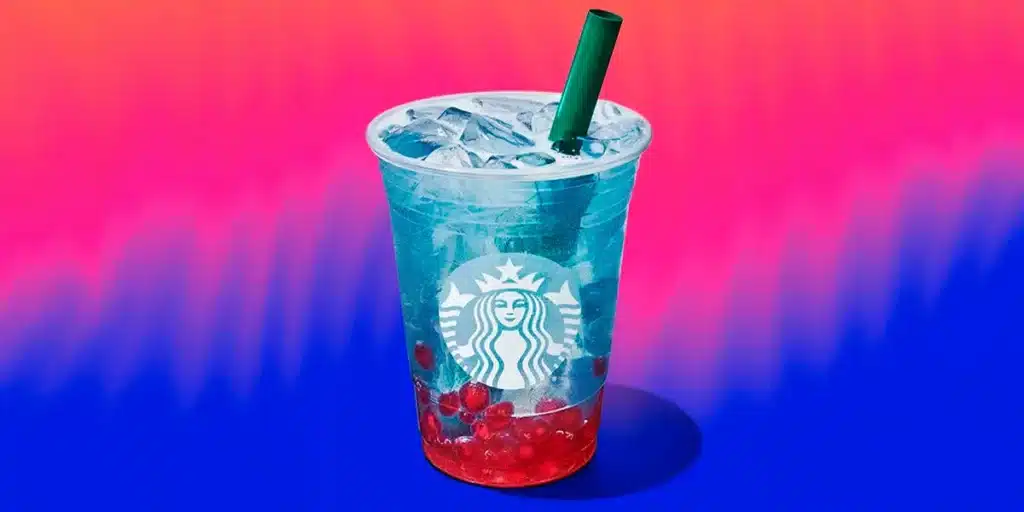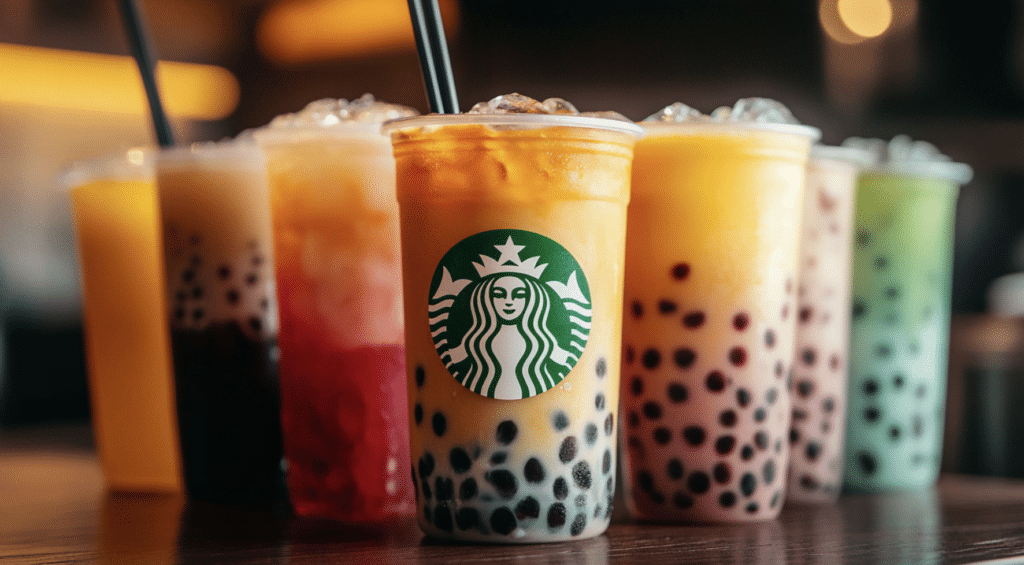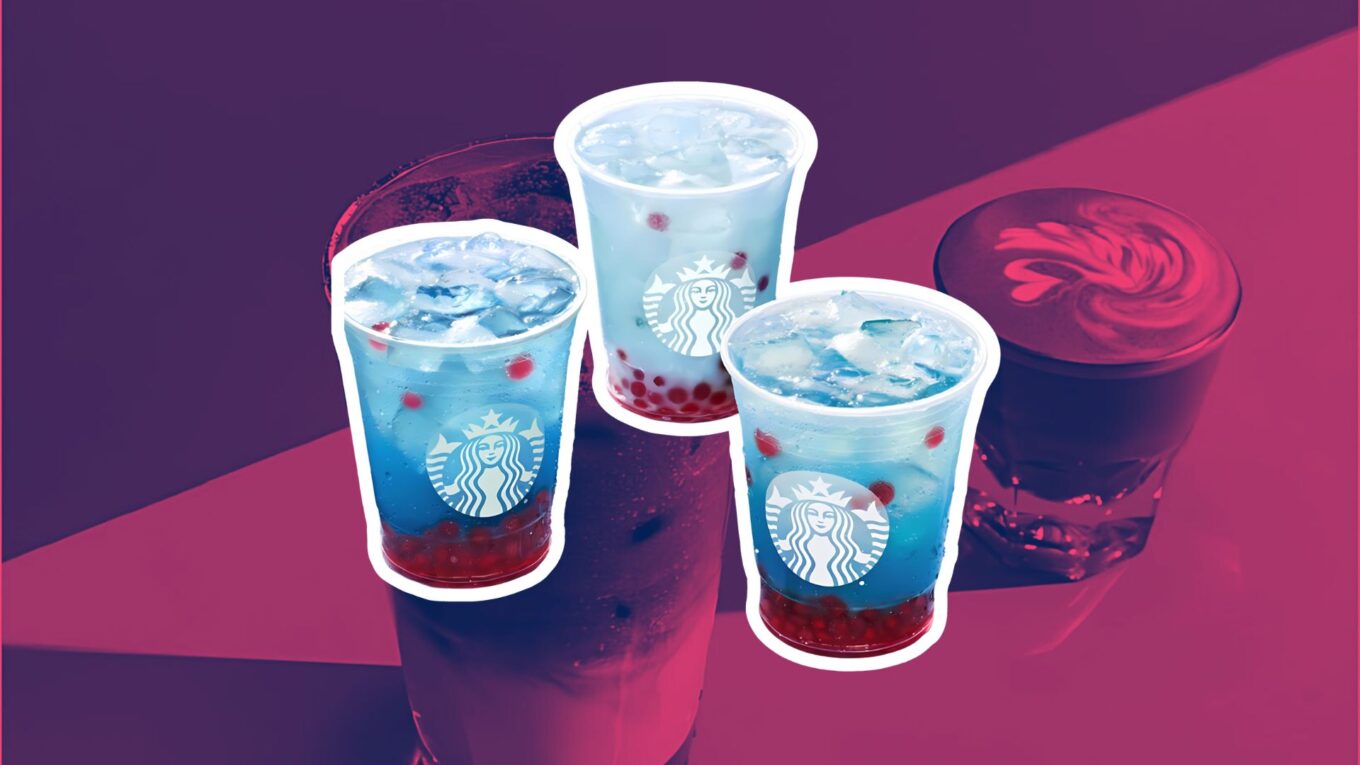Boba tea has become a worldwide favorite, winning over fans with its special mix of tastes and textures.
As this Taiwanese drink grows more popular, even big coffee shops are getting into the act.
Starbucks, a top name in drinks, has seen how much people want this chewy treat. In this post, we’ll look at how Starbucks is joining the boba trend and what that means for tea fans everywhere.
We’ll try Starbucks’ boba drinks, compare them to bubble tea, and discuss what this means for other drink sellers.
We’ll also share thoughts on whether Starbucks can make a mark in the boba world. So grab a drink, and let’s chat about Starbucks’ step into the land of boba!
The Emergence of Boba in Starbucks

1. Starbucks’ Boba Offerings
Starbucks has put a unique spin on boba with its flavored pearls. These small, chewy additions come in varieties like raspberry and coffee, bringing new tastes to the boba world. The raspberry pearls add a fruity kick, while the coffee boosts caffeine.
These special pearls change how people enjoy their drinks. The raspberry ones make fruity teas even tastier, and the coffee pearls go great with milk-based beverages.
They’re not just about flavor – they also add fun textures that make each sip more exciting.
2. Popular Boba Drinks on the Starbucks Menu
Starbucks has created some tasty boba drinks that are getting lots of attention:
- Summer-Berry Lemonade: This drink mixes tangy lemonade with sweet berry flavors. The raspberry pearls make it extra fruity and refreshing.
- Summer Skies Drink: Made with coconut milk, this creamy beverage has berry notes and pearls. It’s a hit with those who like smooth, slightly sweet drinks.
Many customers enjoy these new drinks. Some say they love how the flavors blend, while others like the chewy pearls.
However, a few folks think the drinks are too sweet or that the pearls are smaller than what they’re used to at other boba shops.
3. Customization and Innovation
Starbucks lets you make your boba drink just how you like it:
- Syrups: You can choose from classic sweet syrups, sugar-free options, or seasonal flavors to add to your drink.
- Milk choices: There’s regular milk, but also plant-based options like almond, soy, and oat milk for those who prefer them.
- Toppings: Add fruit jellies or popping boba beside the flavored pearls for extra fun.
Starbucks also keeps things fresh with special boba drinks that change with the seasons. Fall might bring a pumpkin spice boba, while winter could feature a peppermint boba treat.
These limited-time drinks often use flavors people connect with at certain times of the year.
The Global Phenomenon of Boba
Boba Tea’s story began in Taiwan during the 1980s at a teahouse named Chun Shui Tang. This unique drink was created when someone combined cold tea with chewy tapioca balls.
This simple yet innovative idea quickly became a local favorite, showcasing the inventive spirit of Taiwanese cuisine.
The drink’s popularity grew rapidly in Taiwan, with people of all ages enjoying the new texture and taste experience.
From its birthplace in Taiwan, boba tea soon emerged in neighboring Asian countries. Places like Japan, China, and Korea embraced the drink, each adding local flavors and toppings to suit their tastes.
This adaptability helped Boba gain a foothold in diverse culinary landscapes. In the 1990s, Taiwanese immigrants brought Boba to the United States.
At first, it was mainly found in areas with large Asian populations. However, as more people discovered this fun and tasty drink, its popularity began to spread beyond these communities.
Starbucks’ Influence on the Boba Trend
Starbucks has carefully considered the boba trend. They’ve developed a range of boba-inspired drinks that aim to please both longtime boba enthusiasts and those new to the experience.
Their marketing strategies highlight the unique aspects of their boba offerings, often collaborating with popular social media figures to reach a broader audience.
Impact of Starbucks’ Global Presence
With its vast network of stores worldwide, Starbucks has introduced boba to many regions where it was previously unknown.
The familiarity of the Starbucks brand has helped make boba more accessible and less intimidating to those who might be hesitant to try something new.
This global reach has contributed significantly to boba’s growing popularity in various parts of the world.
Starbucks’ Promotional Strategies and Customer Engagement

Starbucks has made a splash in the beverage world with its new boba-inspired drinks. Let’s examine how the coffee giant promotes these products and keeps customers returning for more.
1. Leveraging High Demand for Boba-Inspired Drinks
Starbucks introduced its “popping pearls” drinks in May, and the response was overwhelming. These new beverages flew off the shelves, surprising even Starbucks itself.
The demand was so intense that the company had to slow down its marketing efforts to avoid running out of supplies.
Starbucks CEO Laxman Narasimhan shared some exciting news: the pearls had the best launch-week sales of any new product in Starbucks history. This shows how much customers crave something new and fun in their drinks.
The success of these drinks highlights Starbucks’ ability to anticipate current trends and create products that resonate with its customer base.
By introducing these boba-inspired drinks, Starbucks attracted new customers and gave their regular patrons a reason to try something different.
2. Integrating Boba into Existing Product Lines
The boba-inspired drinks didn’t just do well – they boosted Starbucks’ entire Refreshers line. Sales of Refreshers hit a new high during the quarter, thanks in part to these pearly additions.
Customers are getting creative, too. They’re not just sticking to the set menu; many add pearls to other Refreshers drinks, making unique combinations. This fits into Starbucks’ focus on cold drinks, which comprise 76% of their beverage sales.
This integration strategy shows Starbucks’ knack for innovation within its existing product lines.
By allowing customers to add pearls to various drinks, Starbucks has essentially expanded its menu without having to create entirely new beverages.
This approach increases sales and enhances the customer experience by offering more choices and customization options.
3. Adapting to Customer Preferences
Starbucks is smart enough to jump on the boba trend, which is hugely popular with younger customers, especially Gen A and Gen Z, but it’s putting its own spin on it.
Instead of using traditional chewy tapioca pearls, Starbucks opted for popping pearls, offering a different texture experience.
The company is also adopting customization. Customers can add pearls to various drinks beyond the set menu, allowing everyone to create their perfect pearly beverage.
This level of personalization is particularly appealing to younger generations who value unique experiences and the ability to express their individuality through their choices.
By adapting to these preferences, Starbucks stays relevant and positioning itself as a brand that understands and caters to its customers’ evolving tastes.
This strategy helps build brand loyalty among younger consumers who are likely to become long-term customers.
4. Balancing Innovation with Brand Identity
Interestingly, Starbucks is careful not to use the word “boba” for these new drinks. They’re sticking with “beverages with pearls.”
This clever wording helps Starbucks tap into the boba trend while keeping its unique identity.
By doing this, Starbucks can appeal to boba fans without turning away customers who might not be familiar with traditional bubble tea.
It’s a smart way to bring in new trends while staying true to the Starbucks brand we all know.
This approach demonstrates Starbucks’ skill in brand management. They can introduce trendy new products without diluting their core brand identity as a coffee shop. It’s a light balance that Starbucks seems to be managing well.
Starbucks’ approach to introducing and promoting its boba-inspired drinks showcases its marketing talent and ability to stay ahead of beverage trends while maintaining its brand goodwill.
It’s a strategy that seems to be paying off in terms of sales and customer engagement.
Future of Boba at Starbucks

Innovation and Expansion
Starbucks is always developing new boba flavors. They might establish tropical fruit mixes or dessert-inspired drinks. They’ll offer special boba drinks that fit the season during different seasons.
Starbucks is considering creating new kinds of boba drinks. They might try making boba cold brew coffee or boba matcha lattes.
To come up with these new ideas, they listen to what customers like and look at what’s popular.
Customer Engagement
Starbucks wants to know what you think about their boba drinks. They ask for opinions through surveys and look at what people say on social media. They use this information to make their drinks better and create new ones.
Starbucks plans fun events about boba, like tasting parties or classes where you can learn to make boba yourself.
They also have special deals on boba drinks. These activities help people get excited about boba and want to return to Starbucks for more.
Conclusion
As we wrap up our journey through Starbucks’ venture into the boba world, it’s clear that this Taiwanese treat has found a new home in the global coffee giant’s menu.
While some boba purists might debate its authenticity, this move has made boba more accessible.
We expect to see even more exciting flavors and combinations as Starbucks continues innovating and expanding its boba offerings.
Whether you’re a longtime boba fan or a curious newcomer, Starbucks’ take on this beloved drink offers a fresh perspective on a growing global phenomenon. Why not give it a try on your next coffee run?




